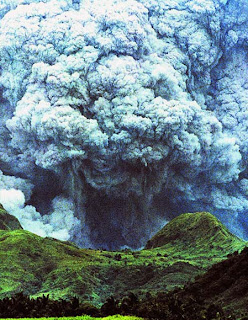
Mount Pinatubo is a lively stratovolcano situated on the island of Luzon, at the junction of the borders of the Philippine provinces of Zambales,Tarlac, and Pampanga. Ancestral Pinatubo was a stratovolcano made of andesite and dacite. Before 1991, the mountain was ordinary and heavily eroded. It was enclosed in opaque forest which supported a population of numerous thousand native people, the Aeta, who had fled to the mountains from the lowlands during the protracted Spanish invasion of the Philippines which first commenced in 1565.

Pinatubo is part of a chain of volcanoes which recline along the western rim of the island of Luzon. They are subduction volcanoes, shaped by the Philippine Plate sliding under the Eurasian Plate along the Manila Trench to the west. Mount Pinatubo lies on a unhelpful cover boundary. The word 'pinatubo' means 'to have made grow' in Tagalog and Sambal, which may propose a information of its preceding outbreak in about AD 1500, although there is no spoken custom among local people of earlier large eruptions. Pinatubo might instead mean a fertile place where crops can be made to grow.Before the disastrous eruption of 1991, Pinatubo was an ordinary volcano, unknown to most people in the surrounding areas. Its peak was 1,745 m (5,725 ft) above sea level, but only about 600 m above nearby plains, and about 200 m higher than surrounding peaks, which mainly hidden it from view. Philippine President Ramon Magsaysay, a native of Zambales, named his C-47 presidential plane "Mt. Pinatubo". The plane crashed in 1957, killing the President and 24 others onboard.

An native group of people, the Aetas (also spelled as Ayta), had lived on the slopes of the volcano and in surrounding areas for numerous centuries, having fled the lowlands to flee harassment by the Spanish. They were a hunter-gatherer people who were very successful in existing in the opaque jungles of the area. These people also grew some clip crops such as wheat, barley and rice.In total, about 30,000 people lived on the flanks of the volcano in barangays (villages) and other small settlements. The opaque jungle covering most of the mountain and surrounding peaks supported the hunter-gathering Aeta, while on the surrounding flatter areas, the abundant rainfall (almost 4 m annually) provided by the monsoon climate and the fertile volcanic soils provided excellent conditions for agriculture, and many people grew rice and other staple foods. About 500,000 people continue to live within 40 km of the mountain, with population centres including the 150,000 in Angeles City, and 20,000 at Clark Freeport Zone.

Several important river systems have their sources on Pinatubo, with the major rivers being the Bucao, Santo Tomas, Maloma, Tanguay and Kileng rivers. Before the eruption, these river systems were important ecosystems, but the eruption filled many valleys with deep pyroclastic deposits. Since 1991, the rivers have been clogged with sediment, and the valleys have seen frequent lahars. Studies show that the river systems will take many years yet to recover from the 1991 eruption. It is nominated as one of the natural wonders.


No comments:
Post a Comment